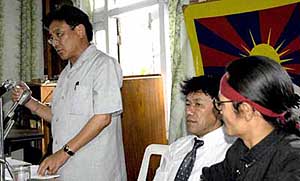
‘Middle Path Approach Under Scrutiny’
(by Pawan Sharma | Hindustan Times | June 3, 2004)

On June 2, 2004, Friends of Tibet (India)
initiated a discussion on "Regional Ethnic Autonomy in Tibet",
the recently published Chinese White Paper on Tibet.
Below is a report by The Hindustan Times.
. . . . . . . . . . . . .
Dharamshala:
The Middle Path approach the Dalai Lama had adopted with the hope
of resolving the Tibet issue has come under close scrutiny of the
Tibetan community with China for the first time officially refusing
to accept the possibility of implementing this system.
The silence being maintained by the Tibetan Government in-exile
over the White Paper on Tibet that China had released on May 23 has
further created suspicion as well as confusion among the Tibetan
community, which has started questioning the so far unsuccessful
middle path approach of their spiritual leader.
That the faith of the exiled community in the middle path is
declining became evident in a public discussion held on Wednesday
evening at McLeodganj on China's White Paper and future of
Tibet. Apart from large number of Tibetans, National Democratic
Party of Tibet (NDPT) president and MP of Tibetan Parliament,
Karma Chophel, Lama Lobsang Jimpa from the Tibetan Department of
International Affairs, Tibetan Youth Congress president Kalsang
Phuntsok and Friends of Tibet general secretary Tenzin Tsundue
participated in this heated discussion that lasted over three
hours. Though the Tibetan community in unison termed the White Paper
as the Black Paper, it raised a serious question mark over pursuing
the middle path. Majority of those participated in this first such
public debate on the future of Tibet were of the opinion that it was
a right time to dump the middle path approach and wanted to adopt
a different policy to force China to resolve the issue of Tibet.
Significantly, the participants were critical of their government
in-exile for the delay in responding to the White Paper, which
according to them, had created a confusion among the common
Tibetans. "There has to be a new thinking. We should adopt the
policy of complete Independence for Tibet," said Karma Chophel an
MP of the Parliament in-exile. He was of the view that as usual
the document was a bundle of unashamed white lies to say the least.
"Only one positive aspect can be considered as a result of this
document. Since Chinese Government has made it crystal clear that
they are not going to concede anything more than the status quo,
it is now for the Tibetan leadership and the people to seriously
reconsider the present policy and plan and think of new ways to
fulfil aspiration of gaining back the lost nation, the NDPT chief
Chophel said.
The concern, which appeared to have been uniformly bothering the
Tibetan community was why their government in-exile was keeping
quiet and that what would be the fate of Tibet struggle in view of
China's rigid approach. The hidden motive of China behind releasing
the White Paper on May 23 is another matter of concern for the
Tibetan community. On May 23, 1951 the 17-point agreement was signed
between China and the then local government of Tibet. China in its
White Paper says that this agreement led to 'peaceful liberation
of Tibet' and laid the foundation for regional ethnic autonomy
in Tibet. However, since long the government in-exile has been
maintaining that this agreement was forced on Tibet. "Is the White
Paper yet another document China wants to impose on Tibet?" is
what some of the common Tibetans have been asking and seeking
answer from their leadership. "People are expressing urgency and
want that new path for Tibet impasse should be found out. They
want some alternative to the middle path approach," said the TYC
president Kalsang Phuntsok.
According to one school of thought that always opposed the middle-path approach of the Dalai Lama, the White Paper has given an opportunity to the government in-exile to formally review it and adopt pro-active approach. It was in June 1988, while speaking at the European Parliament in Strasbourg, the Dalai Lama had proposed genuine autonomy for Tibet wherein Chinese government can continue to "remain responsible for Tibet's foreign policy and defence."
That the demand for not continuing the middle path is gaining can be gauged from the fact that in its budget session this year, the Parliament in-exile passed a resolution stating that unless China withdraws its "unrealistic and untrue" official three pre-conditions put forward to the Dalai Lama and holds a meaningful dialogue, the middle path approach should be reviewed. The Tibetan Parliament had fixed the deadline of March 2005 before the 9th session of the 13th Parliament would begin.
. . . . . . . . . . . . .
China's Stand On Genuine Autonomy:
"It must be pointed out that the local government of Tibet headed
by the Dalai representing feudal serfdom under theocracy has long
since been replaced by the democratic administration established by
the Tibetan people themselves. The destiny and future of Tibet can
no longer be decided by the Dalai Lama and his clique. Rather it can
only be decided by the whole Chinese nation, including the Tibetan
people. This is an objective political fact in Tibet that cannot
be denied or shaken. The situation in Tibet is entirely different
from that in Hong Kong and Macao. Since ancient times Tibet has
been an inseparable part of Chinese territory. With the peaceful
liberation of Tibet in 1951, Tibet had fundamentally extricated
itself from the fetters of imperialism. The socialist system has been
steadily consolidated. So the possibility of implementing another
social system does not exist either. Regional ethnic autonomy is a
basic political system of China. Any act aimed at undermining and
changing the regional ethnic autonomy in Tibet is in violation of
the constitution and is unacceptable to the entire Chinese people,
included the broad masses of the Tibetan people.
|